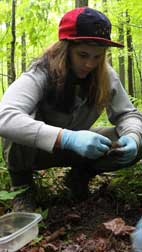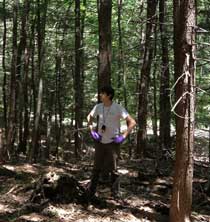 KINGSTON, R.I. – July 16, 2013 – Two students at the University of Rhode Island are spending the summer studying forest ecology as part of the Harvard Forest Summer Research Program, a prestigious Harvard University initiative that teams students with faculty mentors for 11 weeks of environmental research.
KINGSTON, R.I. – July 16, 2013 – Two students at the University of Rhode Island are spending the summer studying forest ecology as part of the Harvard Forest Summer Research Program, a prestigious Harvard University initiative that teams students with faculty mentors for 11 weeks of environmental research.
Arline Gould of Providence and Justin Vendettuoli of North Kingstown, both majoring in wildlife and conservation biology, were among 26 students from around the country chosen from 600 applicants to conduct research at the Harvard Forest in Petersham, Mass.
Gould is studying the growth and decay of fine tree roots by taking high-resolution photographs down narrow pipes inserted into the soil and measuring root growth over time.
“Coarse roots are there to anchor the tree in place, but the fine roots are responsible for nutrient and water absorption. They grow and die every year,” explained Gould, who worked on an organic farm in Costa Rica before enrolling at URI. “Plants take in carbon dioxide from the atmosphere and allocate a significant portion of that carbon to fine root growth during seasonal flushes. When those roots decay, they become part of the soil, which is a process that can account for a huge amount of carbon sequestration in temperate forests.”
Gould said she is enjoying spending every day in the woods and learning about the ecology of the forest.
“The more we understand about the carbon cycle in the forest, the more we understand how it’s going to change as the climate changes,” she said. “This research will hopefully make climate models more accurate and then we’ll be better able to understand how to manage forests in the future.”
 Vendettuoli is spending his summer examining the effects of an invasive insect pest on hemlock trees. The hemlock woolly adelgid is a tiny insect that has been devastating hemlock forests throughout the eastern United States. It builds a wool-like sac to protect its eggs, and the woolly material has a unique chemical composition that may be changing the bacterial communities on the hemlock needles and in the soil.
Vendettuoli is spending his summer examining the effects of an invasive insect pest on hemlock trees. The hemlock woolly adelgid is a tiny insect that has been devastating hemlock forests throughout the eastern United States. It builds a wool-like sac to protect its eggs, and the woolly material has a unique chemical composition that may be changing the bacterial communities on the hemlock needles and in the soil.
“We’re looking at the bacterial abundance on the foliage of uninfected trees versus infected trees, and we’re looking at the impact on the fine roots of the trees as well,” he said. “The hemlock’s response to the adelgid may be to change where it’s storing its nutrients, so we want to see how the flow of nutrients might be changing.”
Vendettuoli, who served in the Americorps Conservation Corps in northern Arizona before entering URI, spends his days driving throughout central Massachusetts searching for hemlock forests and gathering samples of their needles and roots to bring back to a laboratory at Harvard Forest, where he runs tests and counts bacteria.
“It was quite a shock the first time I saw these huge towering stands of trees just covered in adelgid,” said Vendettuoli, who has previous experience studying the invasive pest in a URI lab but had never seen it in the wild. “You could see the woolly sacs from quite a distance, and the needles were just turning gray and dropping off the tree.”
Vendettuoli and Gould say their research experience at the Harvard Forest is helping them to decide on their future career paths, though neither is certain of their plans after graduation yet. They agree that graduate school is in their future, but they both hope to get some work experience before continuing their education.
The Harvard Forest Summer Research Program is funded by the National Science Foundation, NASA and the U.S. Department of Agriculture and has been running for more than 20 years. Working with a faculty mentor, each student completes an independent research project and presents their work at an annual research symposium.
Pictured above
Student Arline Gould examines fine tree roots as part of a study of carbon sequestration in the Harvard Forest. (Photo courtesy of Arline Gould.)
URI student Justin Vendettuoli searches for an invasive pest in a forest of hemlock trees as part of the Harvard Forest Summer Research Program. (Photo courtesy of Justin Vendettuoli.)

